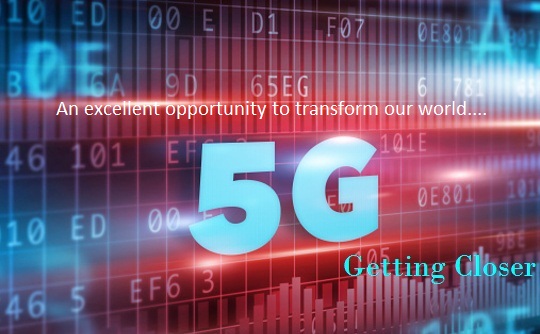5G Networks Getting Closer
Every year the mobile technology providers promise to turbo-charge smartphones with “G” new technology. People are still busy replacing the 3G to 4G and celebrated the fact that they could watch cat videos without their screens locking up (well, most of the time). At the other end, the technology specialists are busy in introducing 5G in the market.
The biggies of mobile technology, Verizon, and AT&T started testing 5G; and if this fifth-generation mobile network works as expected, then it could be far more transformational than the previous versions, accelerating taking up the IoT- smart homes, surgical robots, driverless cars and much more. According to analysts estimate, the number of connected 'things' could more than fifty billion globally by 2020 and reach 500 billion in 10 years.
The 5G rollout is going to be the major extension of the Internet to date and has the potential to create billions of dollars of business for the likes of Ericsson, Cisco Systems Inc., Nokia, Qualcomm, and Intel Corp. All are eagerly waiting in order to grab the advantages of the latest technology and busy in fixing the nuts and bolts of the new networks; their ability to use the contracts that could determine whether some of these companies survive.
“5G is not about another G with super-fast Internet, but, it is about beyond smart phones and tablets.”– says Ericsson Chief Executive Officer Hans Vestberg.
As any Smartphone user can confirm, even the latest 4G networks sometimes drops out while handling millions of people tweeting, watching videos, or playing games. This can’t be good for any provider as it is not enough when a self-driving car needs to choose whether it’s safe to sail through an intersection or has to wait while someone gets the next data packet for the Netflix movie they stream.
So far the beginners or the next generation networks will have to be far more responsive. For years, the industry has mainly focused on the amount of data that can force through the system in a given period of time- with the concept throughput – with only rudimentary attempts to make sure everyone gets what they need during peak time.
The recent focus is latency; how quickly a network can respond to the request. To ensure a robot reacts instantly to a surgeon operating remotely, the 5G networks will have to build in processing, to store data closer and where it is needed and to use multiple forms of radio waves to send and receive traffic. All of this must be controlled by highly developed software that can dynamically adapt what gets sent where and when according to the rapidly changing needs.
The next step is connecting the billions of things directly to each other rather than doing through centrally controlled networks, as most of the connected devices do. Hope the new 5G network would herd together trucks, which would then “talk” to put off high-speed crashes.
Lastly, devices themselves will have to get smarter, and work out what traffic to send when. Not every feeler in a building needs to be able to call the fire department when the temperature spikes, so the networks need to coordinate and prioritize the needs and make sure that they both reduce traffic and assign the right precedence to packets of information that need it.
Nothing will come cheap, so spending on 5G gear will reach $400 billion globally, according to an international networking estimate. If we see building the 2G networks in the early 90s cost a comparatively paltry $130 billion. Companies are eager to benefit and avoid being left behind. Chipmaker Intel gets a chance to finally get into mobile and carry on its shift away from the shrinking PC business. Cisco and Ericsson are bringing their proficiency to the party of mobile equipment for the former; wired gear for the latter.
Network carriers have to make it out loud, as it expects them to be able to charge five times what they’re charging now. This will not be done by jacking up the mobile bills, but by collecting the access fees for the wearable’s, monitors, high-definition virtual reality glasses, smart gears, and by including drone collection, cars, dog collars, bikes, etc. Each connection although be for only a few bucks a month, could run up a heavy tab. Industry experts, of course, say that the benefits will more than the offset cost, and it’s going to be an excellent opportunity to transform our world by connecting every device.
